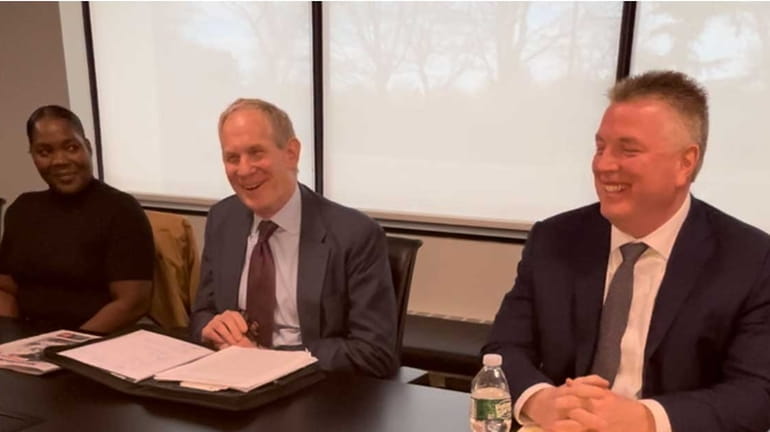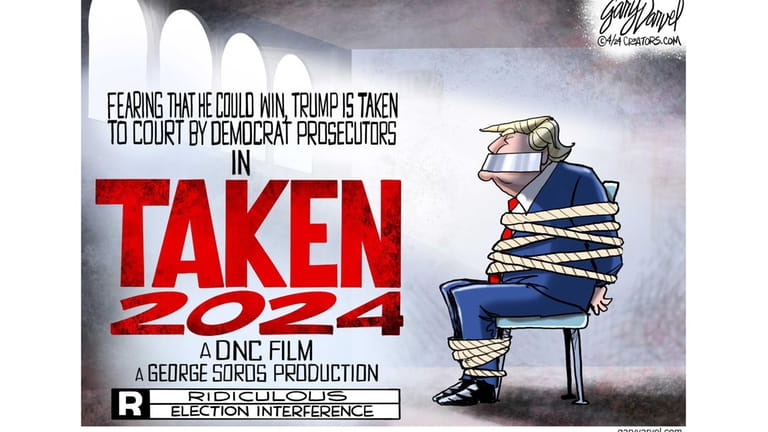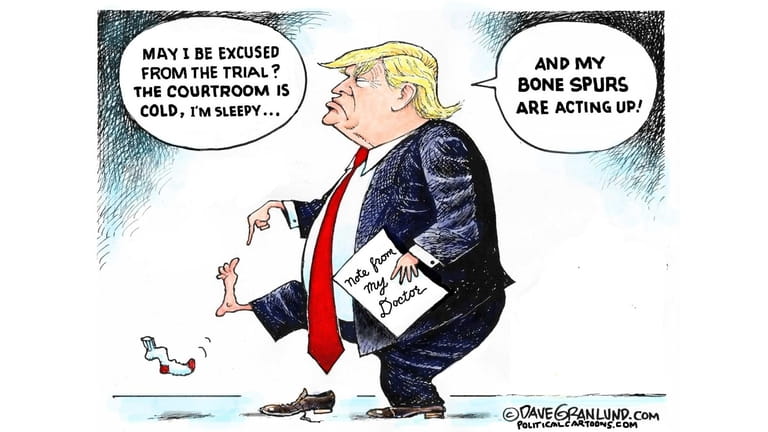MTA leaders visit us on LIRR's 190th anniversary

MTA leaders visited with the editorial board on Wed. April 24. From left to right: Shanifah Rieara (Chief Customer Officer), Janno Lieber (Chair and CEO) and Rob Free (LIRR President). Credit: Christine Wallen
Daily Point
Lieber, Free visit Newsday’s editorial board
Wednesday marks the 190th anniversary of the Long Island Rail Road — and before Metropolitan Transportation Authority executives celebrated at Grand Central Madison with a series of old pictures, videos and music, they joined the Newsday editorial board for a wide-ranging discussion about the LIRR, the oldest transit operation in their system, and about the MTA’s priorities.
MTA chairman and chief executive Janno Lieber noted that on their train ride out to Newsday’s offices, the officials rode along some of the MTA’s more recent accomplishments, including the LIRR’s third track and double track, and passed the still relatively new Elmont station. And he was quick to rattle off other LIRR improvements like the ability to offer additional service along the Main Line, rising on-time performance rates and, of course, last year’s opening of Grand Central Madison.
But Newsday’s board wanted more context about the controversies swirling around the MTA from Lieber and LIRR President Rob Free.
Fare evasion
Lieber came into the boardroom carrying a copy of Wednesday’s paper, which sported a front-page story about the LIRR’s top fare evaders. While the issue is a “huge” problem on subways and buses, Lieber said, he defined it as a “moderate but growing problem” for the commuter railroads.
Lieber said the newly passed state budget will incorporate some solutions identified two years ago by an MTA commission: increased penalties, summonses that are returnable in an MTA administrative court, and added police presence on the trains. For egregious evasion, Lieber wants offenders prosecuted. Lieber said he’s hoping to work “aggressively” with local district attorneys to enforce tougher fare evasion rules, particularly for recidivists.
LIRR’s Free, meanwhile, pointed to the pilot gating program at Penn Station, which is testing ways to check tickets before customers get on the train.
Lieber emphasized the impact fare evasion has on those riders who do the right thing.
“At some point the people who play by the rules in every aspect of their lives start to get demoralized and say, ‘Why should I pay? Why should I be a sucker?’” Lieber said, who told us that the LIRR is now tracking which trains have the highest incidents of evasion and assigning more police to them.
Shanifah Rieara, the MTA’s chief customer officer, said her departments are expanding the messaging to riders to make sure tickets are activated before getting on the train, which not only speeds up the loading process but also cuts down on evasion.
Crime
Lieber emphasized that crime is down in the subways and buses by about 11% compared with five years ago before the COVID-19 pandemic. The LIRR, which sees 10 to 12 serious crimes per month, has seen a decrease, too; on a per-million-riders basis, index crimes are down by a third over the last two years.
But Lieber argued that the combination of National Guard, MTA police and New York Police Department presence not only combats crime but provides “the reassurance of order that sends a positive message …”
Emphasizing that many quality-of-life issues on public transit are caused by those with mental health needs, Lieber said the MTA has now put a more comprehensive approach in place. He and Rieara noted that the MTA is using digital screens and public service announcements to tell riders how to handle incidents on the trains.
Lieber stressed that the relationship between the MTA and NYPD has “never been better,” especially compared with Mayor Bill de Blasio’s tenure, when there was an “arms length” relationship.
“The sense of disorder that’s crept into many of our public spaces is real, and we’re combating it,” Lieber said. “But the crime numbers are actually down.”
Congestion pricing
It was clear that the controversial tolling of cars and trucks headed into Manhattan’s central business district is top of mind for MTA executives. They’re still aiming for a June start date — but the federal court battle between the MTA and New Jersey looms, as a decision will come sometime before the expected start. If the MTA prevails in the first round of litigation, but New Jersey appeals the decision, Lieber said his lawyers assured him that the MTA most likely would be able to start collecting the toll. If NJ wins, however, the MTA expects it could be enjoined from starting the program until appeals are completed. The MTA’s recent announcement that NJ would get a share of the congestion pricing tolls, however, was not directly part of any effort to resolve the legal dispute, Lieber said.
Lieber demurred from defining success for congestion pricing. Will it be more transit riders? Fewer cars on busy Manhattan streets? A seamless technical rollout with no glitches? Lieber said with the summer bringing different seasonal traffic patterns, it will be hard to know right away whether traffic is reduced and transit ridership increased. The real impact will emerge between Labor Day and the December holidays, Lieber predicted.
“By the end of the year, we’ll have the big picture,” Lieber said.
What’s the nightmare for Lieber when it comes to thinking about the upcoming congestion pricing start?
“The real nightmare is that … we don’t run good transit service,” Lieber said. “I think we run great service every day … but we’ve got to make sure we’re running the best possible transit service early in [the congestion pricing process].”
Major projects
Among the most significant items on the MTA’s to-do list is the authority’s five-year capital plan. Discussions are ongoing, but when asked what the plan would include for Long Island and for the LIRR, Lieber focused on the need to “invest to maintain the system.” Lieber pointed to the power system as “antiquated” and highlighted the need for new switches, interlocks and cars.
“We have to invest in the guts of the system,” Lieber said. “It ain’t sexy, but we’ve got to invest in them.”
Lieber said he’s looking at how to invest in new cars when there are only two train car manufacturers — both of which “struggle to meet our needs.”
Electrification of the LIRR’s diesel segments remains the holy grail, and Lieber said he’s “focusing on moving forward with the evaluation of opportunities” both for the Main Line to Riverhead and for the Port Jefferson branch. Lieber and Free both noted the need for additional study to move electrification forward.
“I think that there are some things we can do in the near term,” Lieber said. “I’m just not ready to say exactly when we’re going to get a full electrification of any particular line, but we are focused on it and ready to start there.”
Free told the editorial board that there are complexities with electrifying either line, noting, for example, that the Port Jefferson branch is about 23 miles long, “with an extremely complex geography,” compared with the 10 miles involved in the Third Track effort on the Main Line in Nassau. The Port Jefferson line also would need a double track to see the full benefits of electrification, Free added.
Labor negotiations
While the LIRR’s largest union has come to a deal on a contract that would provide a 9.5% raise over three years, the six other unions have filed for federal mediation. Free, who has been with the railroad for more than three decades, started as a union member.
“I think from a management perspective, our responsibility is to ensure that we continue to provide reliable service,” Free said. “I wouldn’t want to step in between what you would deem as maybe differences between their perspectives and what they negotiated … It’s up to the other labor organizations to determine if they want to come to the table and negotiate other types of work rules and whatnot.”
Lieber said the mediation process could take “a couple of years” and added that he expected that process could be “helpful.”
A downside, Lieber said, of the railroad’s 190-year history is that “There’s sort of a little bit of a hangover of some occasionally old-timey work rules.” So, Lieber said, MTA officials continually attempt to see whether there’s a path toward modernizing work rules and increasing efficiency.
Amenities at Grand Central Madison
The MTA is moving forward with its plans to bring retail to its new terminal beneath Grand Central Terminal, as Lieber defended against criticism that it was late to the table with plans for restaurants and shops. Lieber said those efforts had to wait until after the pandemic, and after Grand Central Madison showed a proven track record, because no one could predict the “eyeballs” and “foot traffic” vendors demand.
Lieber said about 30 applicants have responded to the authority’s request for proposals to bring retail to the new concourse.
Beyond its work at Grand Central, the MTA also is focused on future transit-oriented development opportunities across the LIRR system, specifically where it holds real estate adjacent to train stations and can replace the parking to allow for development.
Free rides
In response to a question about Nassau’s MTA board member David Mack, who has benefited from a grandfathered-in free E-ZPass that’s given him thousands of dollars in free bridge crossings, Lieber said he had no plans to undo the free passes held by only three MTA board members, including Mack.
“There are only three folks left and most of them use it pretty sparingly,” Lieber said.
— Randi F. Marshall randi.marshall@newsday.com
Pencil Points
Cartoonists cover Trump in court

Credit: creators.com/Gary Varvel

Credit: POLITICALCARTOONS.COM/Dave Granlund
For more cartoons, visit www.newsday.com/nationalcartoons
Subscribe to The Point here and browse past editions of The Point here.
